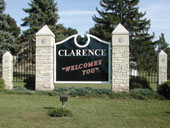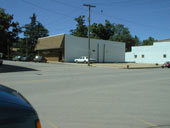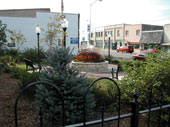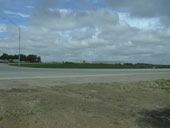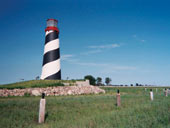AMES, Iowa -- Main Street pocket parks... roadside prairie plantings... town entrance signs... even a lighthouse. All along Iowa's roadways, visible accomplishments like these are testimonials to the success of a one-of-a-kind program that has helped 113 of Iowa's smallest communities.
Now, the Iowa's Living Roadways Community Visioning Program is being recognized nationally. The program will receive the American Planning Association's 2006 Outstanding Planning Award for a Project, Program or Tool at the association's national conference in San Antonio, April 25.
Iowa State University landscape architecture faculty developed the program in 1996. ISU manages it in partnership with Trees Forever, a nonprofit environmental organization based in Marion. The Iowa Department of Transportation funds the program.
The Community Visioning Program provides planning and landscape design assistance to communities with populations of less than 10,000. It helps citizens and officials in rural communities identify issues, set goals, envision designs, develop conceptual plans, write grants and raise private funds. The program brings together teams of ISU design students, professional landscape architects and town residents in a participatory planning process.
And it has a high success rate: Nearly 90 percent of the communities have implemented at least one project, and about 70 percent have ongoing, phased projects under way. Of the 192 projects proposed in the 113 towns, 163 -- 85 percent -- have been completed. Among those are the following:
- Clarence (1997-98 participant) installed new community entry signs and landscaping, converted an empty lot along the main thoroughfare (Highway 30) into a pocket park, and enhanced its city park entrance and the adjoining street with planting and landscaping.
- Storm Lake (1997-98 participant) created a plan to develop a community gateway that would attract visitors from the U.S. 71 bypass. The plan became a reality in 2000 with the construction of a lighthouse and landscaping to represent a lake and shoreline.
- Parkersburg (1998-99 participant) planned landscaping and obtained funding to plant trees along the east entry corridor and two sides of its industrial park. Downtown streetscape improvements are in the works.
- Cherokee (2000-2001 participant) beautified the Highway 59 corridor by planting native grasses, plants and trees along the roadside, and installing a new entrance sign.
- Sheldon (2000-2001 participant) planted 285 deciduous trees and nearly 10 acres of wildflowers and prairie grasses along the Highway 18 corridor.
- Montrose (2003-04 participant) wanted to take advantage of its scenic Mississippi River location and rich history. The visioning process helped the community get a $73,000 National Scenic Byways grant to complete the visioning master plan, which includes enhancements to the entryways and riverfront harbor, and conversion of an elevator into a museum.
The visioning program was created in the mid-1990s by Julia Badenhope, associate professor of landscape architecture, who was extension landscape architect at the time. In her travels through rural Iowa, she saw that small towns lacked the services of professional designers. She developed a pilot program and worked with three communities, honing in on the concept that would become community visioning. In 1996, she approached the Iowa DOT to form a public-private partnership with ISU and private planning and landscape architecture firms. From there, Iowa DOT facilitated collaboration with Trees Forever, which had many community contacts and a shared interest in sustainable community planning and design.
"The program is designed to empower local leaders through a planning process, which ends with an enhancement plan that reflects the values and identity of the community," Badenhope said. "At the end of the process, the community has a better understanding and capacity to do planning."
And, although most community participants do not have the resources for ongoing planning, follow-up surveys show that the visioning program creates interest in other planning efforts, she added.
Montrose Mayor Ron Dinwiddie said the Community Visioning Program helped motivate people in his town.
"The best thing to come out of this for us was a long range plan," he said. "If people have a goal and can look at pictures of what the community will look like down the road, they're more likely to help out with the projects. It makes a big difference."
Each year, 12 communities are selected to participate in the Community Visioning Program. The planning framework integrates technical expertise and local vision in an open, collaborative process. Through community surveys, resource mapping and other tools, the landscape architects and ISU student interns help residents define the major influences that shape the community and its transportation needs. Building on this locally derived view, planning consultants collaborate with the community to visualize alternative solutions to local transportation needs and projects. Proposed concepts are illustrated with maps, drawings, photos and computer-generated images that remain with the community.
"Having ideas and love of the town validated by an outsider is important to people who work hard to make small communities great places to live," Badenhope said.
"With Trees Forever and the landscape architecture community, we do really important work in helping towns thrive. By putting together our knowledge and access to information with good coaching, we help people be successful in making positive changes at a community level," she said.
In general, the program addresses issues common to many small communities: entryway enhancements, visual transitions for towns with new highways or bypass highways, managing signage and billboards, trails for walkers and cyclists, and streetscapes to enhance the walking experience and access to vital community services. The program also emphasizes sustainable landscape development using native plants adapted to the roadside landscape.
"The big idea here is that the cumulative effect of many small actions adds up to a much better quality of life in the countryside of Iowa," Badenhope said.
In addition to Badenhope, the award will be accepted by Mark Kerper, assistant director, Office of Location and Environment, Iowa DOT; Shannon Ramsay, founder and chief executive officer, Trees Forever; and Gary Taylor, ISU assistant professor of community and regional planning.
More information about the Community Visioning Program is online at http://www.communityvisioning.org .
Note to editors: Print-quality digital photos of some projects are available from Teddi Barron, (515) 294-4778, tbarron@iastate.edu.
